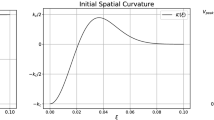Abstract
We present a simplified model of voids in the Universe. Using this model, we investigate the effect of inhomogeneities on light propagation. We calculate the corresponding Hubble diagrams and compare them to those expected in different cosmological models. We find that voids in a universe containing only nonrelativistic matter can mimic accelerating expansion as far as Hubble diagrams are concerned.
Similar content being viewed by others
References
J. T. Nielsen, A. Guffanti, and S. Sarkar, “Marginal evidence for cosmic acceleration from Type Ia supernovae,” Scientific Reports 6 (2016).
A. Feoli et al., “Cosmological constraints from supernova data set with corrected redshift,” J. Phys. Conf. Series 354, 012005 (2012).
M. M. Phillips, “The absolute magnitudes of Type IA supernovae,” Astroph. J. 413, L105–L108 (1993).
D. Kushnir et al., “Head-on collisions of white dwarfs in triple systems could explain type Ia supernovae,” Astroph. J. Letters 778, L37 (2013).
A. G. Riess et al., “Observational evidence from supernovae for an accelerating universe and a cosmological constant,” Astron. J. 116, 1009 (1998).
S. Perlmutter et al., “Measurements of Ω and Λ from 42 high-redshift supernovae,” Astroph. J. 517, 565 (1999).
A. Einstein and E.G. Straus, “The influence of the expansion of space on the gravitation fields surrounding the individual stars,” Rev. Mod. Phys. 17, 120 (1945).
G. Bene, V. Czinner, and M. Vasuth, “Accelerating expansion of the universe may be caused by inhomogeneities,” Mod. Phys. Lett. A 21, 1117–1125 (2006).
T. Biswas and A. Notari, “’Swiss-cheese’ inhomogeneous cosmology and the dark energy problem,” JCAP 2008.06, 021 (2008).
K. Bolejko and M.-N. Celerier, “Szekeres Swisscheese model and supernova observations,” Phys. Rev. D 82, 103510 (2010).
M.-N. Celerier, “The accelerated expansion of the universe challenged by an effect of the nhomogeneities,” astro-ph/0702416.
V. Marra et al., “Cosmological observables in a Swiss-cheese universe,” Phys. Rev. D 76, 123004 (2007).
S. Khakshournia and R. Mansouri, “Matching LTB and FRW space-times through a null hypersurface,” Grav. Cosmol. 14, 295–300 (2008).
M. Lavinto, S. Rasanen, and S. J. Szybka, “Average expansion rate and light propagation in a cosmological Tardis spacetime,” JCAP 2013.12, 35 (2013); arXiv: 1308.6731.
S. Rasanen, “Dark energy from backreaction,” JCAP 0402, 003 (2004); astro-ph/0311257.
M. Mars, F. C. Mena, and R. Vera, “Review on exact and perturbative deformations of the Einstein-Straus model: uniqueness and rigidity results,” Gen. Rel. Grav. 45, 2143–2173 (2013).
A. Notari, “Late time failure of Friedmann equation,” Mod. Phys. Lett. A 21, 2997–3007 (2006).
A. Feoli and E. Benedetto, “Dark energy or local acceleration,” Grav. Cosmol. 23, 240–244 (2017).
C.G. Tsagas, “Large-scale peculiarmotions and cosmic acceleration,” Mon. Not. R. Astron. Soc. 405, 503–508 (2010).
C. G. Tsagas, “Peculiar motions, accelerated expansion, and the cosmological axis,” Phys. Rev. D 84, 063503 (2011).
C. G. Tsagas and M. I. Kadiltzoglou, “Peculiar Raychaudhuri equation,” Phys. Rev. D 88, 083501 (2013).
C. G. Tsagas and M. I. Kadiltzoglou, “Deceleration parameter in tilted Friedmann universes,” Phys. Rev. D 92, 043515 (2015).
S. Del Campo, V. H. Cardenas, and R. Herrera, “Presence of anisotropic pressures in Lemaitre-Tolman-Bondi cosmological models,” Mod. Phys. Lett. A 27, 1250213 (2012).
I. Szapudi et al., “Detection of a supervoid aligned with the cold spot of the cosmic microwave background,” Mon. Not. R. Astron. Soc. 450, 288–294 (2015).
L. A. Thompson and S. A. Gregory, “An historical view: the discovery of voids in the galaxy distribution,” arXiv: 1109.1268.
D. C. Pan et al., “Cosmic voids in Sloan Digital Sky Survey data release 7,” Mon. Not. R. Astron. Soc. 421, 926–934 (2012).
M. Boylan-Kolchin et al., “Resolving cosmic structure formation with the Millennium-II simulation,” Mon. Not. R. Astron. Soc. 398, 1150–1164 (2009).
S. A. Gregory and L. A. Thompson, “The Coma/A1367 supercluster and its environs,” Astroph. J. 222, 784–799 (1978).
P. Sundell, E. Mortsell, and I. Vilja, “Can a void mimic the Λ in ΛCDM?,” JCAP 2015.08, 037 (2015).
K.-i. Maeda and H. Sato, “Expansion of a thin shell around a void in expanding universe,” Progr. Theor. Phys. 70, 772–782 (1983).
K.-i. Maeda and H. Sato, “Expansion of a thin shell around a void in expanding Universe. II,” Progr. Theor. Phys. 70, 1276–1282 (1983).
I. Etherington, “On the definition of distance in general relativity,” Philos. Mag. Ser. VII, 15, 761–773 (1933).
G. F. R. Ellis, “On the definition of distance in general relativity,” I. M. H. Etherington (Philos. Mag. ser. 7, vol. 15, 761 (1933)), Gen. Rel. Grav. 39, 1047–1052 (2006).
V. Springel et al., “Simulating the joint evolution of quasars, galaxies and their large-scale distribution,” Nature 435, 629–636 (2005); astro-ph/0504097.
M. U. Subba Rao and A. S. Szalay, “Statistics of pencil beams in Voronoi foams,” Astroph. J. 391, 483–493 (1992).
R. B. Tully et al., “The Laniakea supercluster of galaxies,” Nature 513 (7516), 71–73 (2014).
Author information
Authors and Affiliations
Corresponding author
Rights and permissions
About this article
Cite this article
Balazs, B., Bene, G. Simplified Model of Voids Able to Mimic Accelerating Expansion at High z without Dark Energy. Gravit. Cosmol. 24, 331–336 (2018). https://doi.org/10.1134/S0202289318040035
Received:
Accepted:
Published:
Issue Date:
DOI: https://doi.org/10.1134/S0202289318040035




